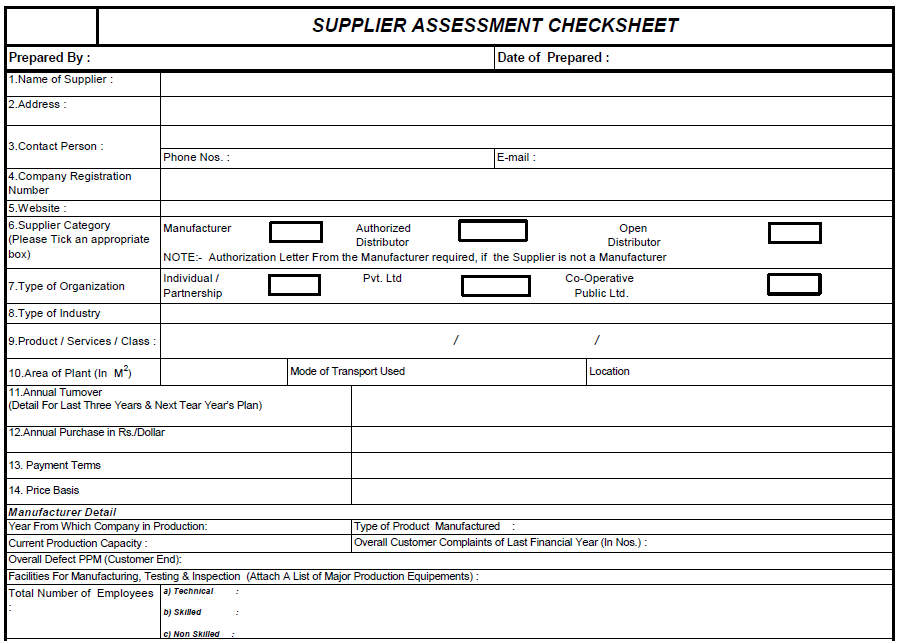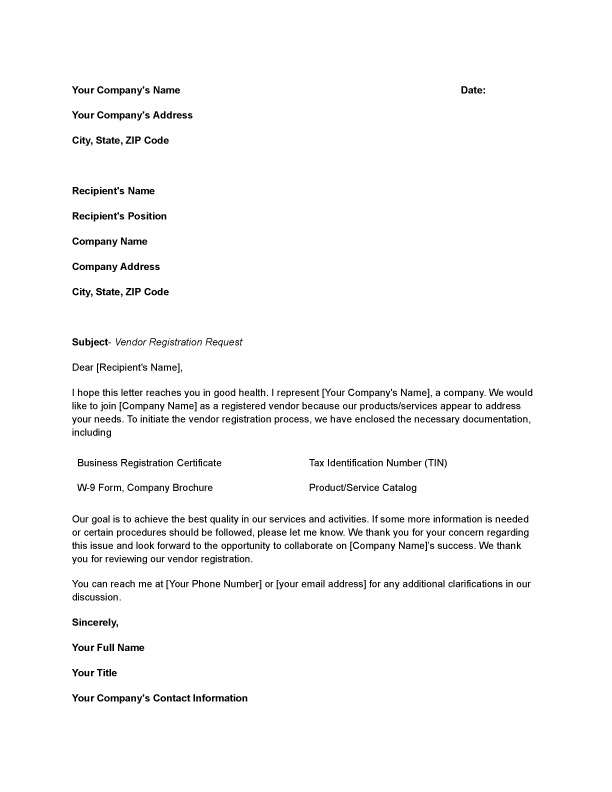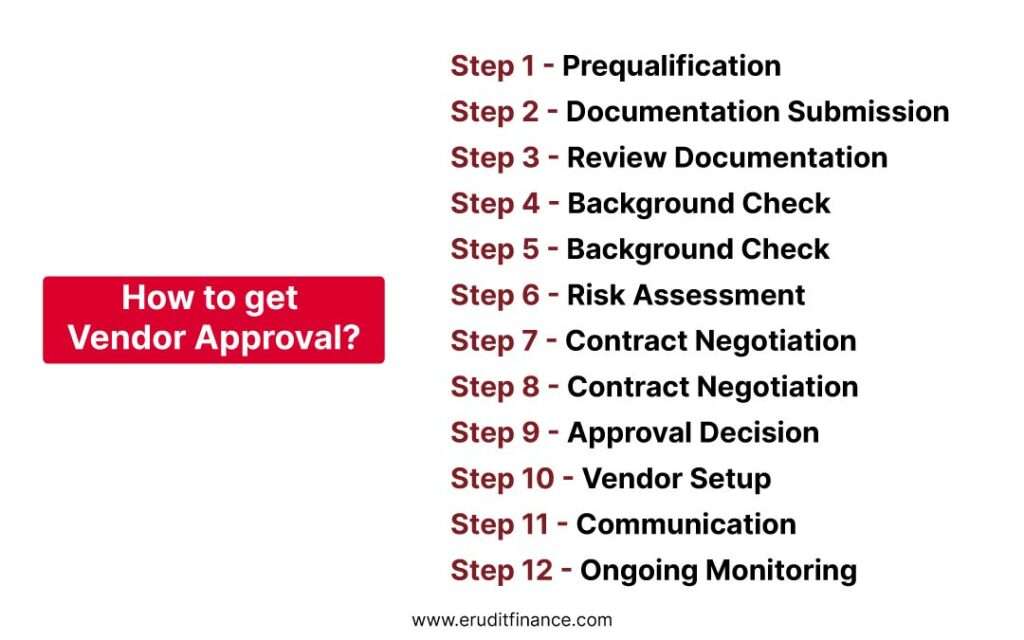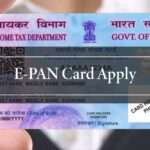Vendor registration request letter to company refers to the system by which a business or individual would apply and become an approved supplier for any organization. This also includes documentation including legal certifications, financial statements, and contacts. Vendor registration is essential for companies to ensure that their suppliers adhere to certain standards and approve regulations. It simplifies the procurement process, enabling companies to have a stable vendor pool and improve productivity across supply chains.
What Is a Vendor Request Form?
It is a vendor request form that organizations use to obtain necessary information from potential vendors interested in being considered for work. This template and lists simplify vendor onboarding by clearly defining the required criteria a vendor should meet to do business with the organization. The template commonly incorporates spaces for the business information and contact details of the vendor, certifications including compliance documents. When using the Vendor Request Form, organizations allow themselves to collect required data for evaluating vendor suitability and making a solid business decision regarding an intended relationship.
Vendor Registration Request Letter To Company
SAMPLE – 1
SAMPLE – 2


SAMPLE – 3
[Your Company’s Letterhead]
Subject– Vendor Registration Request
Dear [Recipient’s Name],
I hope this letter reaches you in good health. I represent [Your Company’s Name], a company. We would like to join [Company Name] as a registered vendor because our products/services appear to address your needs.
To initiate the vendor registration process, we have enclosed the necessary documentation, including
| Business Registration Certificate | Tax Identification Number (TIN) |
| W-9 Form, Company Brochure | Product/Service Catalog |
Our goal is to achieve the best quality in our services and activities. If some more information is needed or certain procedures should be followed, please let me know.
We thank you for your concern regarding this issue and look forward to the opportunity to collaborate on [Company Name]’s success. We thank you for reviewing our vendor registration.
You can reach me at [Your Phone Number] or [your email address] for any additional clarifications in our discussion.
Sincerely,
How Do You Write an Email to a Vendor?
Subject- Inquiry Regarding Vendor Partnership
Dear [Vendor’s Name],
Hope this email finds you well. I am [Your Name], speaking on behalf of[ Your Company Name]. We are currently reaching out to possible partnerships that may improve our supply chain, and your company has been referred to as among the best.
We are interested in learning more about your products/services and would appreciate it if you could provide us with the following information:
A comprehensive product catalog or directory. Price information, including any available discounts for bulk orders.
Terms and conditions for collaboration. Any certifications or documents emphasizing the quality standards of your products and services. If clients or former ones are willing to provide references, these may be used.
Moreover, we would like to arrange a meeting or conference call and talk about how our companies could mutually benefit from the partnership. We need to know when you are available for us to arrange a convenient time if possible.
This request is appreciated. We anticipate the opportunity of working with you and resulting in a mutually rewarding relationship.
Best regards
How Do I Get Vendor Approval?
Getting vendor approval involves a systematic process to assess and approve a vendor for collaboration. Here’s a step-by-step guide.

1). Prequalification- Assess potential vendors based on criteria such as industry reputation, financial stability, and compliance with legal and ethical standards.
2). Documentation Submission- Request necessary documentation from the vendor, including business licenses, certifications, financial statements, and contact details.
3). Review Documentation- Evaluate the provided documents to ensure they meet your company’s standards, regulatory requirements, and industry-specific criteria.
4). Background Check- Conduct a background check on the vendor, including checking references and verifying their track record with previous clients.
5). Site Visit (if applicable)- Conduct on-site visits to evaluate the vendor’s facilities, processes, and quality control measures.
6). Risk Assessment- Evaluate potential risks associated with the vendor, including financial stability, legal compliance, and data security measures.
7). Contract Negotiation- Engage in negotiations to establish clear terms and conditions, ensuring they align with your company’s policies and expectations.
8). Approval Committee (if applicable)- If your organization has an approval committee, present the vendor’s case for review and approval.
9). Approval Decision- Make a decision based on the comprehensive assessment. Approve or disapprove the vendor based on the gathered information.
10). Vendor Setup- Once approved, set up the vendor in your systems, including adding them to relevant databases, procurement systems, and communication channels.
11). Communication- Inform the vendor of their approval status and any additional steps required for collaboration.
12). Ongoing Monitoring- Implement a system for ongoing monitoring of vendor performance, compliance, and adherence to agreed-upon terms.
By following a structured vendor approval process, you ensure that your organization engages with reputable, reliable, and compliant vendors, fostering successful and transparent business partnerships.
What Information Do I Need From a New Vendor?
When onboarding a new vendor, you’ll need various pieces of information to ensure compliance, establish a transparent partnership, and facilitate effective communication. Key information to collect from a new vendor includes.
| References | Financial Documents | Business Information | Data Security Measures |
| Contact Details | Certifications & Licenses | Contractual Documents | Billing & Payment Details |
| Tax Information | Insurance Information | Quality Control Measures | Compliance Doc |
Collecting this comprehensive set of information will not only help verify the legitimacy of the vendor but also ensure that they meet your company’s standards, regulatory requirements, and operational needs.
How Do I Verify a New Vendor?
Verifying a new vendor is a crucial step to ensure reliability and compliance. Here’s a guide on how to verify a new vendor.
- Collect Vendor Information- Request necessary documents such as business licenses, tax identification numbers, and certifications.
- Check Legal Compliance- Verify that the vendor adheres to legal requirements, including any industry-specific regulations.
- Financial Assessment- Assess the vendor’s financial stability by reviewing audited financial statements, credit reports, or other relevant financial documents.
- Reference Checks- Contact the vendor’s previous clients or partners to gather feedback on their performance, reliability, and professionalism.
- Evaluate Reputation- Utilize online resources, reviews, and industry forums to assess the vendor’s reputation within the business community.
- Site Visits- Conduct on-site visits, if possible, to evaluate the vendor’s facilities, operations, and quality control measures.
- Insurance Coverage- Confirm that the vendor has appropriate insurance coverage to mitigate potential risks.
- Contract Review- Carefully review and negotiate contractual terms, ensuring they align with your business needs and expectations.
- Data Security- Assess the vendor’s data security measures to safeguard sensitive information and comply with data protection regulations.
- Ongoing Monitoring- Establish a system for ongoing monitoring of vendor performance, periodically reassessing compliance and efficiency.
By systematically verifying a new vendor, you mitigate risks, ensure regulatory compliance, and build a foundation for a reliable and transparent business partnership.
Bottomline
In conclusion, vendor registration is a critical step in establishing successful business partnerships. This process not only ensures compliance with standards and regulations but also fosters transparency and reliability. As businesses strive for efficiency and excellence in their supply chains, selecting and onboarding vendors through a well-structured registration process becomes paramount. By prioritizing due diligence, effective communication, and ongoing evaluation, companies can forge lasting and mutually beneficial relationships with vendors, contributing to overall organizational success.











Great work! This is the type of info that should be shared around the web. Shame on the search engines for not positioning this post higher! Come on over and visit my website . Thanks =)
Hello There. I discovered your weblog the use of msn. This is a very neatly written article. I will make sure to bookmark it and come back to read extra of your helpful info. Thanks for the post. I will definitely comeback.
Good write-up, I am regular visitor of one抯 blog, maintain up the excellent operate, and It’s going to be a regular visitor for a lengthy time.